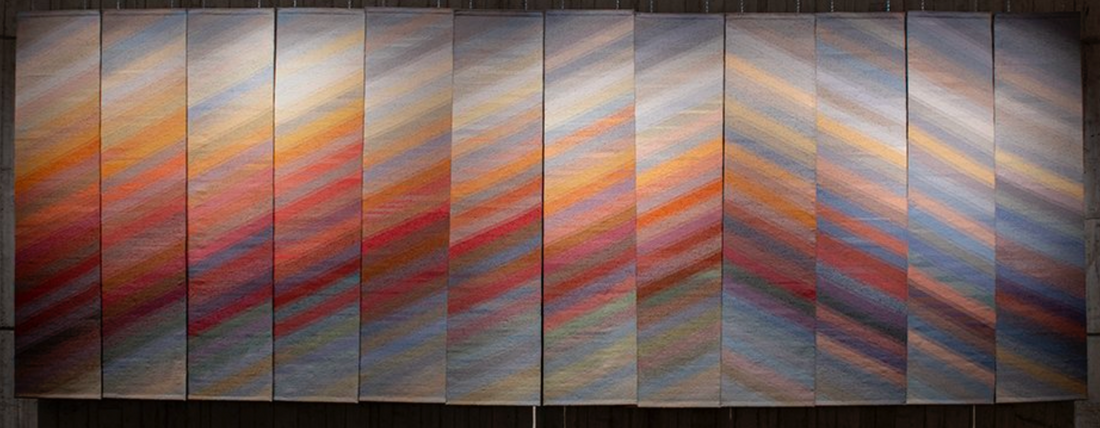
PRAIRIE INTERLACE: Weaving, Modernisms & the Expanded Frame, 1960–2000, Nickle Galleries, Calgary, Alberta, Canada
I have travelled across Canada many times and love the drive through the Prairie provinces where the sky is so immense you can see changes in the weather from many kilometres away. Violets, pinks, oranges, soft blues, and greys transition into the beiges, golds, browns and ochre of the land. The landscape is subtle, expansive and full of texture. Years ago when I was studying Geography, I learned about a holistic approach to observing and studying the environment. This was my introduction to the notion of complex systems understanding that a whole is the sum of its parts, that every part must be considered in relation to the others and that the parts functioning together constitute the behaviour of the whole. This exhibition is an extraordinary example of a weaving community whole and it's coming into being. The community developed across a vast space and through a time when local weavers and newcomers who had settled in the Prairies shared their knowledge and artistry, working in collectives, schools, and guilds. Home may be where you come from but it is also where you make it within a community you choose blending cultures, experiences, and ideas.

As I walk into the Nickle Galleries I am enveloped by a monumental warmth. The entrance is a low-ceilinged, white-walled space that quickly gives way to a brutalist concrete gallery with vastly high ceilings. The warmth that I experience in this space is bestowed by the enormous weavings and fibre works that fill the gallery. As the title promises, the exhibition exemplifies the soft power of fibre, elements of modernism, body politic, fierce experimentation, and exceptional technical prowess. One is presented with a collection of work by artists who have called the Prairie provinces of Canada home for a significant period.

The idea of the Prairie landscape is echoed in much of the work in this exhibition. Kaija Sanelma Harris’s Sun Ascending evokes the colour, light, and scale of a Prairie experience. Though the Nickle Galleries is only displaying 12 of the 24 86 x 396 cm panels of Harris’s piece, I am still in awe of the scale, virtuosity, and finesse of this tapestry. The colours shift subtly in diagonal lines across all the panels evoking the changing light in the Prairie sunrise. The soft wall of the tapestry panels beautifully challenges the cold hard concrete of the gallery. Sun Ascending was originally woven for the TD Centre in Toronto to soften the brutalist concrete architecture of the building, one of many similar-purposed commissions in the 1960s and 1970s.
The spring and summer textures in the Prairies vary and depend on the crops grown. In the fall, the dark rich soil is exposed with remnants from the fields, and in the winter the prairie is blanketed with snow; the horizon disappears. I am captivated by a hammock-like installation by Carol Little. Furrow is a vibrant red/orange cloth with a subtle Ikat pattern evoking the undulating fields of the prairie captured by the late-day summer sun. It is wonderful to see a weaving suspended horizontally in space, the lines of the warp curved to echo a landscape.
Heading through the gallery I am in front of Nepenthe, by Susan Barton-Tait. Her work is an experimental off-loom woven piece that pushes out from the wall and into my space. The large, tangled root-like structure is evocative of both a tree and the internal body, a heart-like organ shape with valves, and chambers. The brown and beige colours are from the hair of Nepenthe, Barton-Tait’s dog, that have been spun into yarn and woven into the piece. There is a material density to this work. It speaks of time, rhythm and intimacy both in space and of the body.

Charlotte Lindgren’s sculptural Winter Tree invites contemplation of place. A flat woven piece, Winter Tree has been shaped onto a circular armature, suspended and animated by air movement in the gallery. The gallery lighting conjures memories of lambent light and long shadows thrown by deciduous trees on a winter day.
At the end of the long gallery, I am wooed by the work of the Sioux Handcraft Cooperative from Saskatchewan. The centrepiece, a geometric latched-hook rug of truly prodigious dimensions, dominates the space. There is an altar-like arrangement of the 12 richly coloured symmetrically designed rugs in this area creating a sacred viewing experience for me.

It is not only the weavings in this exhibition which are extraordinary, there are also striking crochet, macramé, and rug-hooking works in a range of styles, from representational to conceptual. I cannot possibly discuss them all, though many of them are worthy of serious consideration. I will close with Imago (viii) translatable Is That Which Denies, by Mary Scott. This work shifts the modernist emphasis of the exhibition and presages post-modernism. Scott deconstructs a woven silk cloth by removing warp threads from one end and the weft threads from the other, leaving a small panel in the middle onto which she embroiders a feminist image, recontextualised from Leonardo. The fine threads of the unwoven tangled warp create their own drawing. Scott’s cloth has been as carefully deconstructed as the other works in the exhibition have been constructed.
I have returned to this exhibition many times because it exudes a powerful energy. The limitless nature of fibre arts is on compelling display here with work made by artists, and the community they built together.
Text by Barbara Sutherland
prairieinterlace.ca
